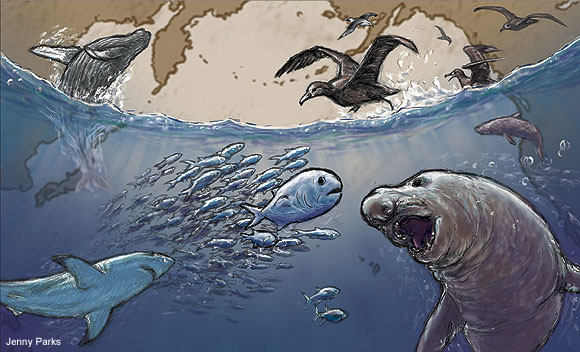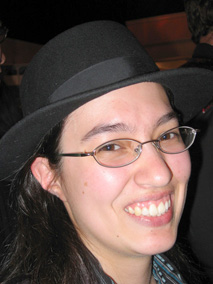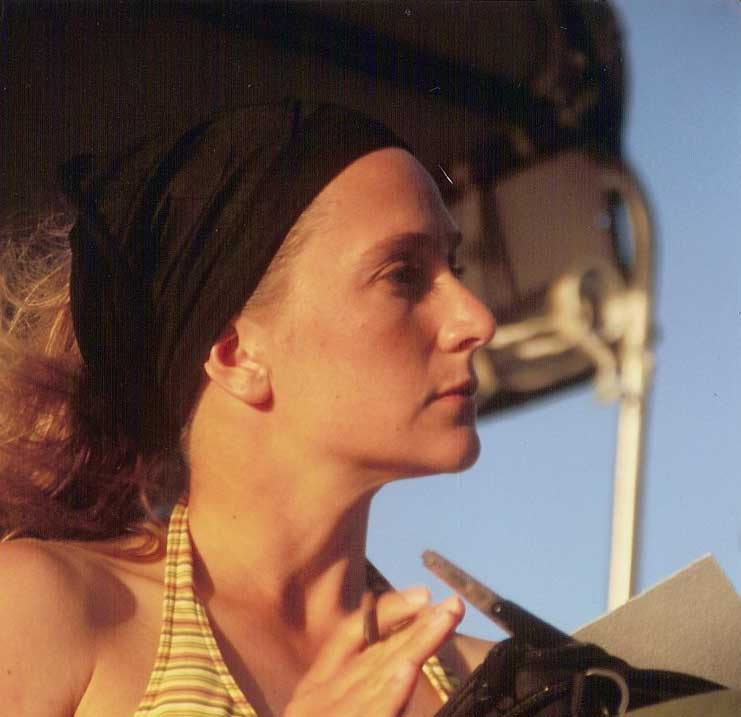
In the pre-dawn hour along Highway 1, a carload of young marine biologists turns onto a dirt road in Año Nuevo State Reserve. They roll slowly past signs reading, "Drive Slow, Endangered Snakes." It is a brisk 40°F, too cold for a snake to be out. Waiting for them at a ranger station are their teammates and a truck packed tightly with instrumentation and supplies.
The morning will be busy, so fourteen hands quickly unpack the truck. Wearing identical blue windbreakers with "UCSC Research" in yellow on the back, the researchers unload a red tarp, a giant tripod, medical supplies, a cooler, a large yellow bag, and a scale, plus odds and ends. As light creeps over the redwoods of Big Basin State Park to the east, they begin a ritual hike through tall grass and bony shrubs to a hidden beach.
The sky grows pink and orange, and the grass thins. The ocean emerges, still dark blue, but getting lighter. Along the path are grayish-black lumps, some more than 2.5 meters long. They lie motionless, except for large black eyes that watch the procession suspiciously.

A male elephant seal.
Soon the din of a distant crowd wafts back, and the sand becomes increasingly peppered with the lumps. Moving eyes give way to moving noses—the big, floppy noses of male Northern Elephant Seals.
"The males usually leave us alone," says Nicole Teutschel, an undergraduate in marine biologist Daniel Costa's lab at the University of California, Santa Cruz, as she points to a male not 3 meters away. "The females are a little more aggressive."
With one look, it's clear why. The beach before them is littered with hundreds of seals, most with newborn pups at their sides. The females bark at each other; their pups squeak and cry. The males roar as if beating a large hollow drum, and they fight for territory and breeding rights. Many bear scars and blood-crusted open wounds.
After eight months at sea, traveling up to 15,000 kilometers to forage for fish and squid, the seals have returned to give birth and rest. On this beach is one special seal with a small box stuck to her head, housing a satellite receiver. The scientists are here to get it back.
TOPP-down conservation
Seals like female 37591 carry instruments that help Costa and a group of oceanographers, marine biologists, and ecologists learn what populates the open sea. They use animals as oceanographers, because they go where ships do not. The data returned by the animals give researchers information to protect them and their threatened feeding grounds.
Through the Tagging of Pacific Pelagics (TOPP) program, more than 2500 seals, birds, whales, sharks, fish, squid, and turtles have tracked the ocean through environmental and location monitors, affixed by scientists on shore and at sea. The instruments log and transmit the travels of these animals, which researchers anxiously wait to decipher.
Based on the central California coast, TOPP is part of the Census of Marine Life, a global effort to identify every organism, past or present, in the ocean. Now in its seventh year, TOPP focuses on "top predators," marine species high in the food chain. As data accumulates from their travels, a startling convergence of animals has emerged. Many species faithfully travel from different locations to the same spots in the Pacific Ocean, presumably looking for food. In this meet-to-be-eaten scenario, Costa and the TOPP scientists think they have identified biodiversity hotspots—geographic regions where a variety of animals come together.
"Six or seven years ago, we noticed interesting parallels between tuna and other species," says Costa. "Eight tagged species use waters from central to southern California. The path some travel stretches out in a straight line with a couple of spots along the way, and others move along southern Alaska. These are biodiversity hotspots."
Hotspots vary in size. The island of Madagascar is a terrestrial hotspot with hundreds of unique species evolved during thousands of years of isolation. Most of California and southern Oregon also is a large hotspot, with redwoods and giant sequoias rooting entire civilizations of plants and animals, as is Baja California in Mexico, where subtropical temperatures propel species diversity.
Terrestrial hotspots are rapidly losing ground to humans, who relentlessly change the land and alter ecosystems. The sea is suffering the same fate, biologists warn.
The ocean is harder to protect because of its size, says Costa, and because ownership is rarely clear-cut. The biodiversity hotspots revealed by TOPP may represent manageable chunks of ocean, where conservation efforts could yield more bang per buck.
"You can't protect the entire ocean," says Costa. "Can we make it tractable? Finite? Can we take a small piece out of the ocean and save 30 percent of a species? Conservation biology is in a vacuum of knowledge. My goal is to feed that need."
Ecologist Paul Ehrlich of Stanford University agrees on the need for knowledge. He recently published a paper criticizing terrestrial hotspot conservation. The definition of a hotspot, he says, is surprisingly incomplete. In some cases, hotspots fare worse in protecting species than does the surrounding unprotected land, because regulations do not consider animal movement in and out of the hotspot.
In the long run, Ehrlich thinks data from TOPP and similar programs may help the biodiversity hotspot approach work for ocean conservation through marine protected areas (MPAs), much like the network of marine reserves slated to preserve the California coastline. Costa is off to a good start, Ehrlich says, but things must move faster. Demand is rising, and many fish in the middle of the food chain become luxury seafood.
"MPAs are a good idea, and conservation is eventually possible, but levels of consumption by the rich could eventually vacuum the oceans dry," Ehrlich foresees.
Oases in the ocean
Animal migration data from TOPP show two clear areas of convergence. The first is more a line than a spot, from the California coast westward into the Pacific Ocean. Animals join the line from places along the way, including northern Hawaii and other islands. The second is a rotating body of water in the Gulf of Alaska.
While the two spots differ in size, shape, and location, they have one key thing in common, says Steven Bograd, a TOPP oceanographer with the National Marine Fisheries Service: Both sites are rich in microscopic plants called phytoplankton.
To survive, phytoplankton convert sunlight to energy through a molecule called chlorophyll. In the process, the plants absorb carbon dioxide and release oxygen. As the base of the food chain, they draw the small animals that draw fish, in turn drawing predators like sharks, whales, seals, and birds. Without them, there would be no ocean ecosystem.
The line extending west from California is called the "transition zone chlorophyll front." It's a major, well-known Pacific Ocean feature rich in phytoplankton compared to surrounding waters. What's new, says Bograd, is the appearance of so many different marine animals, including elephant seals and albatrosses. Without tags, scientists would have had no idea of the numbers and species that visit.
"It's a zone of convergence," says Bograd. "Elephant seal females tend to head straight out, and they know the feature. They hang out for a couple of months because they know there's going to be good feeding." The front fluctuates northward or southward about 10 degrees in latitude every year and seems permanent, he says.
The other hotspot corresponds to a large eddy, a swirling flow of water that travels along the British Columbia coast toward the Gulf of Alaska. The eddy is born through a process called upwelling. It starts from mineral-rich waters crashing along the shore. Coastal water is dense and cool, so it tends to sink during most of the year. But strong winter winds push the eddy out to sea. The mineral-rich water fuels phytoplankton growth, creating a moving smorgasbord for ocean animals. The Gulf of Alaska eddy lasts for about a year before it peters out. The next winter, it re-forms off British Columbia and the cycle repeats.
The faithful return of animals to the eddy is perplexing, since it travels thousands of kilometers before dissipating. "These animals go out of their way to find the eddy. We don't understand how they know where to go," says Bograd. "They follow the same path year to year. How do they navigate and remember where it is?"
Some of those answers may lie in mounds of data from tagged animals. Yann Tremblay, who works with Costa, created programs to turn lists of numbers into a graphical representation of an animal's tracks. As tagging technology improves, Tremblay can chart elephant seals moving just 10 meters at a time, seemingly circling in specific areas within the hotspot. This fine movement, he thinks, may precede a decision to dive for food or to move on to richer ocean.
Such analysis, now ongoing, should provide insights into seal behavior that the scientists otherwise could only see by traveling alongside the animals in the ocean. Costa expects to discover new hotspots within the deluge of data.
Fresh data on the beach
Several newborn pups see their first sunrise this morning. Scavenging birds circle overhead, watching for discarded placenta. A radio signal bounces off a receiver attached to female seal 37591 to confirm she is on the beach. Jason Hassrick and Patrick Robinson, two of Costa's graduate students, scan the beach with binoculars, looking for her. Last May, they helped tag 27 seals here just before their eight-month foraging trips. Searching for food, seals dive 600 to 800 meters—and sometimes up to 1500 meters—holding their breath for at least 20 minutes.
Soon, they signal. She is deep in the pack, with protective females barring the way. Waving their arms and the tarp, they confuse the females into retreating, their pups scooting behind them. They forge a path to their data, anaesthetic in hand. Once they reach her, they quickly inject the anaesthetic and wait for it to kick in.
Meanwhile, the rest of the team stays behind and checks tubes to collect blood and milk. They grab a small ultrasound device to measure her blubber. They prepare instruments to remove the satellite receiver from her head, as well as a time-depth recorder from her back, both attached with a piece of mesh and epoxy. A tape measure appears, and researchers hoist weighing materials onto their shoulders.
Soon, the whole team assembles by the groggy seal. All fourteen hands work quietly to avoid disturbing her neighbors. Everyone knows his or her responsibility. The female's pup panics; eventually, a team member restrains him for his own safety.
After taking specimens and measurements, the team must weigh the mom and pup using an industrial scale hooked to a giant tripod. They weigh the wriggly pup in the yellow sack. Meanwhile, others coordinate to roll the female onto the tarp.
Someone says, "One, two, three, go." They move the scale and hoist the tarp, the sleepy female's head peeping out the side. Full of blubber that she converts to milk, she weighs 464 kilograms—more than 1000 pounds.
Finished in an hour, the team packs up quickly. All but Hassrick move back up the beach. He must ensure the mom recognizes her pup when she comes to, or else he will become an orphan. Unless he is adopted, he could die. Pup mortality is high even in the best of times, and Costa's team does not want to add to it.
Airborne sensors
Elephant seals are just part of the picture for Costa and the TOPP project. Scott Shaffer, another TOPP researcher, tags albatrosses—large seabirds that travel great distances for food. Albatrosses extend the team's knowledge from deep in the ocean to the sea surface and air above. Their tags measure sea surface temperature; when compared to light intensity measurements during the course of a day, the data also reveal their location above the open ocean.
With their long narrow wings, albatrosses can easily cover 500 kilometers at a stretch by gliding. Nineteen albatross species are endangered, because their feeding territory overlaps with fishing fleets that use long baited lines. The lines snare the birds when they attack the bait. Shaffer and his team has studied Black-footed and Laysan albatrosses on the northwestern Hawaiian Islands and in Baja California for five years.
His group finds that the birds also frequent the transition zone chlorophyll front and the Alaskan eddy, but most likely go to different spots than the elephant seals do to find food. While one parent sits on an egg, the other hunts for food for several days at a time, landing when it possibly sees or smells the surface-dwelling prey.
After the chick hatches, the parents must stay close by to feed the chick often. Shaffer wonders whether the slight variation in the front's location may affect the success of that year's breeding effort. If the front is too far north, it may be harder to get food and get back quickly. After their chicks reach 25 days old, the birds can stay away for longer foraging trips.
Laysan albatrosses head straight north and prefer to feed in colder water, Shaffer says. Black-footed albatrosses head toward the generally warmer waters of the Pacific coast. His team is now studying what happens when the adult birds leave their chicks to fend for themselves, and where they go. They also want to study where the fledglings go; like elephant seal pups, the young birds must figure out how to feed themselves once mom and dad are gone.
The albatross data will enhance the emerging picture, Shaffer says. "One animal is not an ecosystem," he says. "TOPP is going to make its splash because in studying sharks, turtles, tuna, albatrosses, and seals, we're not saying. 'Let's see what the seals are doing,' but 'Where is the overlap? What is the common feature?' It's very powerful information, because it tells us what should be preserved or protected."
Mother and child reunion
At Año Nuevo, it is nearly 9 a.m. The team moves to another side of the beach to find its second seal. She is tightly wedged among females aggressively guarding their pups. Males mill around the edges, alternately napping and swimming. Frustration rises as the researchers try to approach her. They finally succeed, but they have to move fast.
The first tourists arrive by 10 a.m.; park rangers ask the UC Santa Cruz team to wrap up by then. Costa's team strives to keep seals and their pups safe and healthy, but visitors may misunderstand their procedures from a distance and think they are harming the seals. Getting out quickly prevents defensive explanations.
Meanwhile, Hassrick is having trouble reuniting the first seal with her pup. She lunges at him repeatedly, so he swats her nose with his baseball cap to surprise her back into place. Another team member joins him to tend to neighboring females stirred by the drama, so Hassrick can focus on the reunion.
As Costa's students work diligently on both sides of the beach, the first wave of tourists peeks over a ledge, heads stuck to binoculars. Another scientist and a ranger explain why Hassrick is swatting his seal and why the team is trying to weigh their pup. Soon, the reunion is settled; Team Costa is done for the moment.
The young scientists waste no time in packing up and hiking back up the beach to their cars. Here the team of seven splits, some to return to campus, some to hit a beach to the north. They have another rendezvous with a half-ton oceanographer carrying secrets of the deep.
ABOUT THE WRITER
Megha Satyanarayana
B.S., biology, Tufts University
Ph.D., molecular biology, University of Texas Southwestern Medical
Center
Internship: Charlotte (N.C.) Observer
 I like both the natural world and the mechanical world, but Iíd like to
see them get along a little better. Shouts of "Science and technology
destroys!" often drown out the constant whisper of "Technology can make
things better." I see one abiding problem: Those with information, when
they share, donít share it very well. Whatís the point of knowing stuff,
if youíre the only one who knows it? After eight years of becoming an
expert in random areas of biology—stomach pathogens, AIDS immunity,
and aging in model organisms—my brain is full and needs to be
cleared. Science writing, aside from being a sort of empirical garage sale
("Information—used, but in good condition!"), satisfies my need to
share knowledge. I'm ready to reveal what science can do for us.
I like both the natural world and the mechanical world, but Iíd like to
see them get along a little better. Shouts of "Science and technology
destroys!" often drown out the constant whisper of "Technology can make
things better." I see one abiding problem: Those with information, when
they share, donít share it very well. Whatís the point of knowing stuff,
if youíre the only one who knows it? After eight years of becoming an
expert in random areas of biology—stomach pathogens, AIDS immunity,
and aging in model organisms—my brain is full and needs to be
cleared. Science writing, aside from being a sort of empirical garage sale
("Information—used, but in good condition!"), satisfies my need to
share knowledge. I'm ready to reveal what science can do for us.
ABOUT THE ILLUSTRATORS
Jenny Parks
B.F.A., illustration, California College of the Arts, San Francisco
 A large part of my life has been consumed by my two loves: animals and
art. I originally went into illustration with a desire to draw and tell
stories, and although there was an emphasis on editorial art in the
illustration department at CCA, I managed to always find room for an
animal or a hint of nature into my works. Trips to amazing places like the
Galapagos Islands spurred my imagination, and I would try to find plenty
of time to wander through zoos with my sketchbook. But it would be the
inspiration from the beautiful natural illustrations of my thesis
instructor Dugald Stermer, that my decision to go into that field finally
solidified. His staunch support of my abilities gave me the encouragement
I needed. I couldnít think of a more suitable way to meld my fascination
with science and nature with my passion for drawing.
A large part of my life has been consumed by my two loves: animals and
art. I originally went into illustration with a desire to draw and tell
stories, and although there was an emphasis on editorial art in the
illustration department at CCA, I managed to always find room for an
animal or a hint of nature into my works. Trips to amazing places like the
Galapagos Islands spurred my imagination, and I would try to find plenty
of time to wander through zoos with my sketchbook. But it would be the
inspiration from the beautiful natural illustrations of my thesis
instructor Dugald Stermer, that my decision to go into that field finally
solidified. His staunch support of my abilities gave me the encouragement
I needed. I couldnít think of a more suitable way to meld my fascination
with science and nature with my passion for drawing.
Amy Whitesides
B.A., environmental studies, University of California, Santa Cruz
 I grew up in the mountains of Salt Lake City, Utah. Not far from our door
I could look for bat caves, watch the aspen leaves twist in the wind, and
dip my feet in the crisp cold water of Little Cottonwood Creek. These
experiences led me to value natural resources above all else. I studied
environmental studies and biology with the idea that I would work as a
conservation biologist. I found, however, that I liked to interact with
science in a different way than those around me who really liked research.
After realizing I didnít want to be a ìscientist,î I eventually made my
way to the Science Illustration program, where my interest in scientific
inquiry and conservation has found a medium in which it can comfortably
exist. I look forward to pursuing these interests through the powerful
mixture of education and beauty that is science illustration.
I grew up in the mountains of Salt Lake City, Utah. Not far from our door
I could look for bat caves, watch the aspen leaves twist in the wind, and
dip my feet in the crisp cold water of Little Cottonwood Creek. These
experiences led me to value natural resources above all else. I studied
environmental studies and biology with the idea that I would work as a
conservation biologist. I found, however, that I liked to interact with
science in a different way than those around me who really liked research.
After realizing I didnít want to be a ìscientist,î I eventually made my
way to the Science Illustration program, where my interest in scientific
inquiry and conservation has found a medium in which it can comfortably
exist. I look forward to pursuing these interests through the powerful
mixture of education and beauty that is science illustration.
